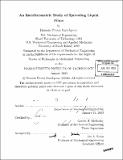An interferometric study of spreading liquid films
Author(s)
Kavehpour, Hossein Pirouz
DownloadFull printable version (17.09Mb)
Other Contributors
Massachusetts Institute of Technology. Dept. of Mechanical Engineering.
Advisor
Gareth H. McKinley.
Terms of use
Metadata
Show full item recordAbstract
Moving contact line problems involving polymeric materials and other complex fluids are encountered in many applications such as coating flows, gravity-driven drainage, and spin-coating operations. Viscous, capillary, inertial and gravitational forces can all be important in these flows depending on the scale and speed of the spreading process. In this research, a number of benchmark problems involving moving contact lines of viscous Newtonian and non-Newtonian polymeric fluids have been studied using non-invasive optical techniques. A detailed study of viscous Newtonian and non-volatile liquids spreading on smooth horizontal and inclined substrates is presented. A phase-modulated interference microscope was used to enable the simultaneous measurement of both the inner (microscopic) length scale and the outer (macroscopic) flow scale in addition to the intermediate matching region. The resulting measurements of both the apparent contact angle and lateral scale of the precursor wetting film agree quantitatively with theoretical predictions for the spreading of a van der Waals fluid over a wide range of capillary numbers (10-6 < Ca < 10-1). It is also shown that the dynamic contact angle of a perfectly wetting Newtonian fluid is not only a function of the capillary number (the Hoffman-Voinov-Tanner law), but also depends on a logarithmic correction to this relationship, which is often overlooked. It is shown that both the microscopic and macroscopic length scales affect this logarithmic correction. Our measurements are in good quantitative agreement with available theoretical predictions. In addition to the steady, isothermal spreading of fluids, we have studied instabilities of volatile liquid films spreading on thermally conductive surfaces. (cont.) When a drop of volatile silicone oil is deposited on the surface of a smooth silicon wafer, its thickness decreases with time in a power-law form as it spreads under the action of capillarity. At a critical thickness, traveling waves can be observed on the free surface of the film, and a confocal microscope was used to measure the amplitude, frequency, and non-linear evolution of these waves. We interpret these waves in terms of Marangoni instabilities induced by surface tension gradients close to the contact line, generated by liquid evaporation. The spreading of highly entangled polymer melts (Z > 10) on a solid surface is also considered. Our experiments confirm the existence of a non-Newtonian 'foot' region in the vicinity of the moving contact line for highly entangled polymer melts. Our experimental results of the lateral and vertical scales of this 'foot' are in fair agreement with available theoretical predictions. The transient spreading motion of an ideal elastic 'Boger' fluid (consisting of a dilute solution of high molecular weight polymer dissolved in a viscous Newtonian solvent) is also investigated. It is shown that the spreading rate of this model elastic fluid is smaller than is observed for corresponding Newtonian fluid drops of similar size and viscosity due to the viscoelastic effects. A foot-like structure is detected at the leading edge of the droplet for these unentangled, elastic fluids as well ...
Description
Thesis (Ph. D.)--Massachusetts Institute of Technology, Dept. of Mechanical Engineering, 2003. Includes bibliographical references (p. 201-212).
Date issued
2003Department
Massachusetts Institute of Technology. Department of Mechanical EngineeringPublisher
Massachusetts Institute of Technology
Keywords
Mechanical Engineering.